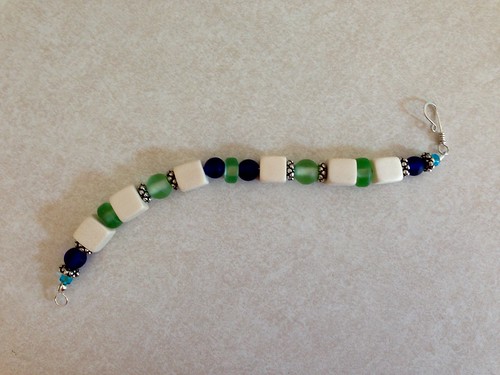Adventures in Handmade Jewelry is right.
Here's my latest and what I learned from it.
Design is very important, but like all good designs it must work. It must function well and enhance the time you spend using it.
I bought these cute little wooden cubes recently and had a design all done and finished. I loved it. Isn't it cute?
I even had a name for it picked out (no, not Jeff). Then I tried to put it on.
And realized I couldn't.
It wouldn't bend enough to do up the clasp easily. Take a look -
The most flexible part of the design is where the flattest part of your wrist is. Uh. Wrong. The bendiest part should be at the sides of the wrist. Right where I put those cute little cubes. Cute, but not bendy. Not comfortable all that much either.
What happens to jewelry that's difficult to put on or wear?
It sits in the drawer and collects dust. Or it gets tossed away if you're the letting go type.
So back to the bench. This design works much better - it can be put on easily and is comfortable on the wrist. It also has better balance both for keeping the wood cubes up and in terms of overall aesthetics. I dig it and even though it cost me some frustration (and a torn thumbnail - I bleed for my art!) I like it much better and will definitely keep wearability in the front of my mind as I create.
That's my lesson for today. Spend time thinking about how your piece will be worn. Get in front of a mirror and try on your own work. See how easy or hard it is to do the clasp. See how it drapes or curves around your body. Study the effect of how an earring actually dangles from your lobe. If it's awkward, uncomfortable or can't be put on or off easily - scrap it and start over.
You'll have happier customers!
Here's my latest and what I learned from it.
Design is very important, but like all good designs it must work. It must function well and enhance the time you spend using it.
I bought these cute little wooden cubes recently and had a design all done and finished. I loved it. Isn't it cute?
I even had a name for it picked out (no, not Jeff). Then I tried to put it on.
And realized I couldn't.
It wouldn't bend enough to do up the clasp easily. Take a look -
The most flexible part of the design is where the flattest part of your wrist is. Uh. Wrong. The bendiest part should be at the sides of the wrist. Right where I put those cute little cubes. Cute, but not bendy. Not comfortable all that much either.
What happens to jewelry that's difficult to put on or wear?
It sits in the drawer and collects dust. Or it gets tossed away if you're the letting go type.
So back to the bench. This design works much better - it can be put on easily and is comfortable on the wrist. It also has better balance both for keeping the wood cubes up and in terms of overall aesthetics. I dig it and even though it cost me some frustration (and a torn thumbnail - I bleed for my art!) I like it much better and will definitely keep wearability in the front of my mind as I create.
That's my lesson for today. Spend time thinking about how your piece will be worn. Get in front of a mirror and try on your own work. See how easy or hard it is to do the clasp. See how it drapes or curves around your body. Study the effect of how an earring actually dangles from your lobe. If it's awkward, uncomfortable or can't be put on or off easily - scrap it and start over.
You'll have happier customers!



Comments
Post a Comment